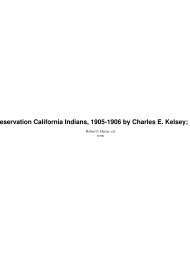Everything Photographic: J. T. Boysen and his ... - Yosemite Online
Everything Photographic: J. T. Boysen and his ... - Yosemite Online
Everything Photographic: J. T. Boysen and his ... - Yosemite Online
You also want an ePaper? Increase the reach of your titles
YUMPU automatically turns print PDFs into web optimized ePapers that Google loves.
proofs at the studio ." If that was not enough, <strong>his</strong> was " theonly studio kept open during the winter ."As these statements suggest, <strong>Boysen</strong>'s was not theonly photographic studio in the Valley . His competitorsincluded photographers Arthur C . Pillsbury, D. J.Foley, <strong>and</strong> Harry C . Best . And while <strong>Boysen</strong> was generallycooperative in <strong>his</strong> dealings with park managers <strong>and</strong> theother concessionaires, the presence of so many studiosinevitably caused tensions . For example, each day all ofthe studios would set up cameras around Mirror Lake tophotograph visitors . In 1916, A . C . Pillsbury proposedthe studios alternate their days at the lake instead . Firsttried during the 1915 season, the arrangement frustrated<strong>Boysen</strong> . "Many mornings, for some reason, either or bothof my competitors failed to be there," he wrote in a letterto the park. When the park supervisor instructed the studiosto continue the alternating-day plan, <strong>Boysen</strong> complainedin a second letter. " I abhor these controversies,<strong>and</strong> have no intention to be arbitrary, <strong>and</strong> am seekingno special privilages [sic], but endeavoring to defend mybusiness interests ."Photography would provide <strong>Boysen</strong> a career as wellas a family. In 1899, Mabel Sweetl<strong>and</strong>, a native of theSan Joaquin Valley hamlet of Lemoore, was working as ateacher in San Francisco . She happened to visit <strong>Yosemite</strong>Valley that summer with two of her students . She met J .T.when she took her film to be processed at <strong>Boysen</strong> ' s Studio.After a brief romance, the pair were married in Lemooreon February 11, 1900 . On November 6, 1900, their onlychild, Ellen, was born in Lemoore.Mrs . <strong>Boysen</strong> became a true partner in the photographybusiness . Among other work around the studio, she wasa " saleslady <strong>and</strong> colorist " who h<strong>and</strong>-tinted photographsthat the studio framed <strong>and</strong> sold .Julius T. <strong>and</strong> Mabel <strong>Boysen</strong>, almost certainly taken on the occasion of their wedding inLemoore in 1900 .Mabel <strong>Boysen</strong> had an unusually close relationship withmany Native Americans who lived in the Valley . In a 1934interview, she recalled that she " would have been verylonely when I came here if it had not been for the Indians.They were good to me <strong>and</strong> there were often several ofthem sitting around the rooms of my house "In addition to selling baskets until 1915, the <strong>Boysen</strong>samassed a substantial personal collection, part of whic<strong>his</strong> now in the <strong>Yosemite</strong> Museum collection . Mabel <strong>Boysen</strong>was also a judge in the basket competition at some of theIndian Field Days held in the Valley from 1916 to 1930.The <strong>Boysen</strong>s' unusually close association with NativeAmericans would lead to some of J . T. <strong>Boysen</strong>'s mostsignificant images . He took a number of portraits of<strong>Yosemite</strong>'s native people, including a 1901 photo of PaiuteIndian Suzie McGowan carrying her daughter Sadie in abeaded cradleboard.Despite <strong>his</strong> professional success, <strong>Boysen</strong> suffered fromserious health problems that affected <strong>his</strong> work. As earlyas 1919, Mabel <strong>Boysen</strong> <strong>and</strong> her father contacted a formeremployee about buying the studio . And in June 1920,51-year-old <strong>Boysen</strong> himself wrote to SuperintendentLewis stating <strong>his</strong> "desire to dispose of the photographicbusiness in <strong>Yosemite</strong> known as the <strong>Boysen</strong> Studio ."Nothing came of t<strong>his</strong>, because in September 1920, J .T.applied again for <strong>his</strong> annual permit, asking that it " bemade in favor of Mrs . <strong>and</strong> Mr. J. T. <strong>Boysen</strong> instead ofJ. T. <strong>Boysen</strong>" because <strong>his</strong> " sickness, last summer, compelledher assuming the management exclusively <strong>and</strong> inevery sense she is an equal partner ."In 1924, the Park Service began moving businesseslike <strong>Boysen</strong> ' s Studio to the north side of the Valley to thepresent location of <strong>Yosemite</strong> Village . By that December,the Park Service had a plan <strong>and</strong> elevation for <strong>Boysen</strong> 's socalledNew Village studio designedby Herbert Maier. The building,wrote Park Superintendent W.B.Lewis, would be "a frame structurewith shake roof, sided with bark, <strong>and</strong>with stone foundation ."After some construction delaysdue to <strong>his</strong> health, <strong>Boysen</strong> movedinto the structure in the spring of1926 . The "new " <strong>Boysen</strong> Studio stillexists just west of the Post Office ; itis now the NPS Wilderness Centerwhere visitors can obtain permits forbackcountry camping, climbing <strong>and</strong>other activities.But health issues continued toplague <strong>Boysen</strong> . In 1934, the <strong>Boysen</strong>swrote to the NPS Director askingthat their contract be changed toYOSEMITE ASSOCIATION, FALL 2008 5



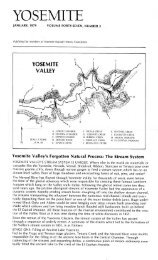
![(March 1982) [PDF] “We Are Pleased to Announce†- Yosemite Online](https://img.yumpu.com/51299748/1/190x242/march-1982-pdf-aeuroewe-are-pleased-to-announceaeur-yosemite-online.jpg?quality=85)
![[PDF] Old Horny, Yosemite's Unicorn Buck - Yosemite Online](https://img.yumpu.com/51269869/1/184x260/pdf-old-horny-yosemites-unicorn-buck-yosemite-online.jpg?quality=85)
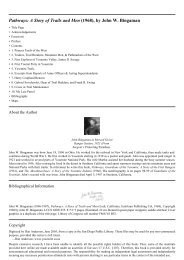
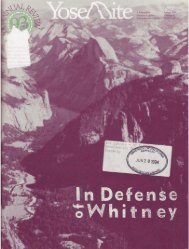
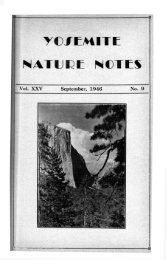
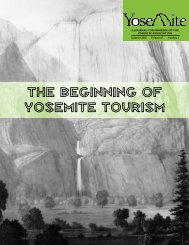
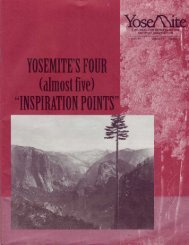
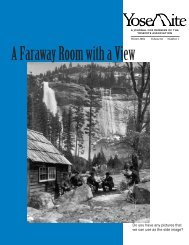
![1985 [PDF] - Yosemite](https://img.yumpu.com/48128837/1/184x260/1985-pdf-yosemite.jpg?quality=85)

